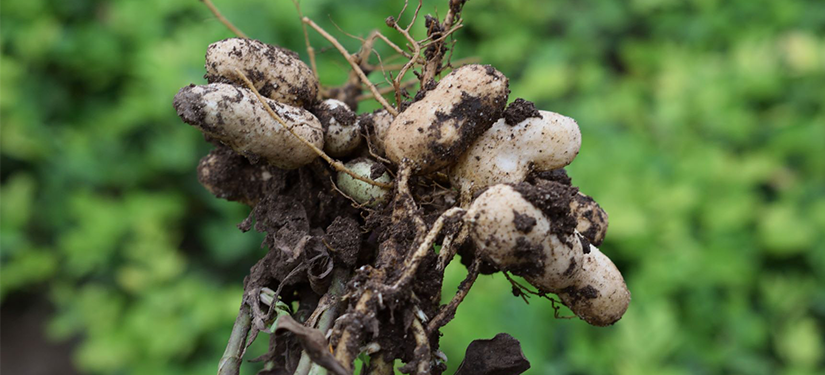
In India and Mozambique, Tanager works with smallholder farmers on reducing aflatoxin contamination in peanut crops. Reducing aflatoxin contamination requires identifying pain points in the supply chain where aflatoxin can infect yields and introducing smallholder farmers to techniques that can reduce moisture.
To better understand the challenges of this work, we talked to Joseph Boulier and Rajiv Ranjan who work with peanut farmers in Gujarat. Through the Mars Inc-funded Mangal Moongfali project, Tanager is working to make this region a potential source of high quality peanuts.
Aflatoxin contamination in peanuts is a serious problem for Indian farmers, as it destroys what could be a lucrative market. But it seems like there’s not a lot of knowledge at the farm level about aflatoxin. Could you take us through why that’s the case?
Rajiv Ranjan: Smallholder farmers don’t see aflatoxin as a problem so much because no one has really told them. It is more of a recognized problem for the processors, especially premium processors who export to international markets. This is also an issue for local traders, who are more accustomed to notice fungal contamination in any given lot of ground nuts. And there is a high correlation between visible fungal contamination and high levels of aflatoxin. But nobody was telling the farmers.
Joseph Boulier: It’s complicated because aflatoxin is very difficult to measure. So farmers will harvest their stock, and if you want to get an accurate reading of aflatoxin, you have to follow a rigorous and expensive process. There’s a specific way of piling the peanuts, and you have to take handfuls from different levels of the pile, you have to remove a significant portion of your crop, then put that portion through a series of expensive tests. That’s the only way to understand what the level of aflatoxin is within a crop. So in an average transaction between a farmer and a buyer, there isn’t a great way to measure it easily. So traders are eyeballing farmers crop, and as Rajiv mentioned, they look for things that might correlate with aflatoxin damage. So if it’s moldy or damaged then they might knock down the price a little.
How does Tanager work to address this knowledge gap?
Rajiv: As part of the project, we have conducted group meetings, and distributed information about the importance of aflatoxin contamination and how quality of a crop correlates with the price farmers receive.
Joe: Yes, as Rajiv said, a big part of it was educating farmers on what the purpose of the program was and having farmers recognize that their peanut crop could be fetching better prices if farmers can achieve a higher quality. The way the supply chain has evolved in India has not put much emphasis on being able to sort crops at the farm level. Farmers are just selling their peanuts in bulk and the processors sort it out, so at this point the processors are the ones able to benefit from the higher quality peanuts.
Rajiv: Yes, so farmers are aware of the market potential. But we are the first project in this area to highlight the quality issue, and how that could benefit farmers.
What other factors come into play in the Indian market for peanuts?
Joe: The minimum support price, or MSP, is a factor. At the beginning of the year, farmers can register their peanut growing land with the government. Based on your land size, the government will purchase a certain amount from you. And that government rate is typically pretty high – usually 10-20% higher than the market price. So most of the time, a lot of farmers will reserve some of their stock just to sell to the government. It’s what they do with the rest of the stock is really what the project was focused on. Is there a way to help farmers grow high quality peanuts and store them in a safe and effective manner? So they can sell part of their crop to the government, but get higher prices for what’s left over. For the farmer, the goal is to maximize yields, more than focus on quality. There’s never been an emphasis on quality.
Also, almost all of these farmers are doing livestock, and the peanut serves two roles: they sell the nuts to the government and to traders, and the tops are used as fodder for their livestock. When we first went out and did the survey work many of the farmers saw the fodder as more beneficial than the actual peanuts, as they can rely on the MSP.
Because of all these different factors, the Indian market has evolved differently than other peanut growing countries. They have this huge domestic market with a fixed price. On top of that they know they can sell the fodder. So what’s evolved is that the farmers don’t have to worry about quality very much. Even though they’re the second largest peanut producing country in the world, not much of that is earmarked for high quality supply chains.
There are also blending techniques that can really make testing for aflatoxin difficult at the farm level. The big enforcement mechanism is when you export it. Peanuts from India are heavily tested at ports. It really only happens at the export level. There’s never been strict enforcement around Aflatoxin, which is why companies like Mars have issues within the Indian market, because it’s such a new way to buy.
What challenges does Tanager see at the farm level with adoption of techniques to reduce aflatoxin contamination?
Rajiv: One of the main things we’re trying to get farmers to adopt is related to the drying process. Drying peanuts upside down can greatly reduce aflatoxin. But there’s additional cost in doing that, so farmers are reluctant to do that. The other GAP practices are easier to adopt.
Joe: Our research told us that the faster you can dry peanuts below 6% moisture, the better quality of your peanuts, and that has to happen fast. Also we found that you can reduce fungus and aflatoxin if you don’t leave any crop in the ground, and sort it as soon as you can. But that is a very manual and work intensive process. And even if you take all of these steps, someone could still find aflatoxin if they choose the wrong handful of peanuts, it could still have aflatoxin.
What has the project learned that could be useful for others working on aflatoxin contamination?
Joe: From the process of planting the seed all the way through harvesting, storing and processing, there are many points where Aflatoxin can crop up. We have identified 33 different points where aflatoxin can infect a crop – so what we wanted to identify with this project is which of these points is the most effective place to invest in to reduce aflatoxin.
Our big finding is that there’s a correlation between damaged and discolored peanuts and aflatoxin percentages. So we know that when a farmer harvests, sorting can be a big factor in reducing aflatoxin. That’s one big learning. The other recommendation would be, looking for ways to dry peanuts quickly and separate out damaged and discolored peanuts and that way you can reduce the vectors for aflatoxin.

